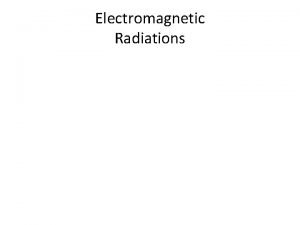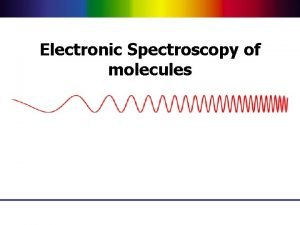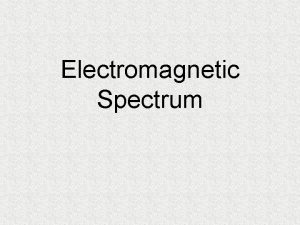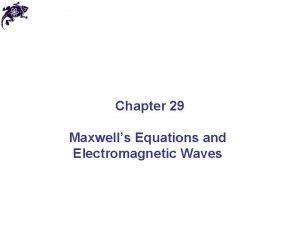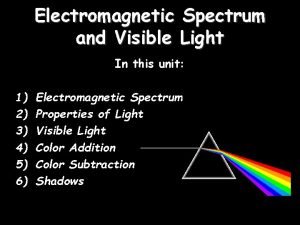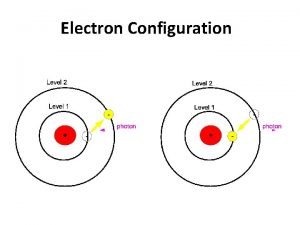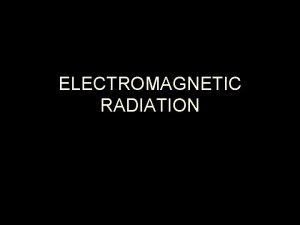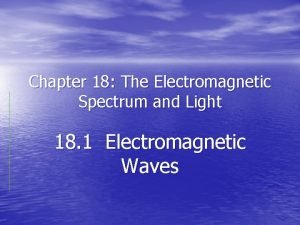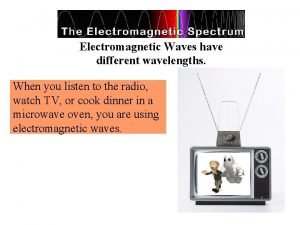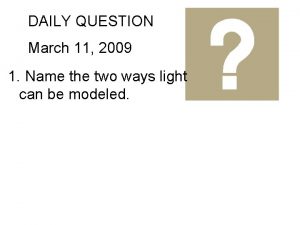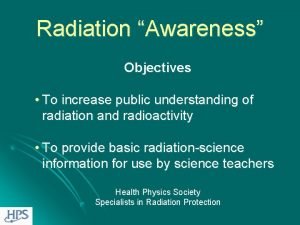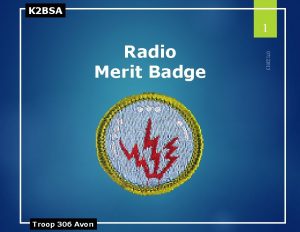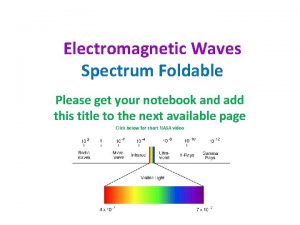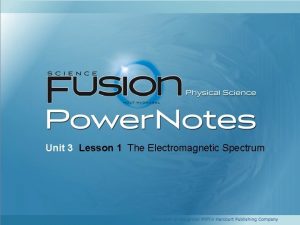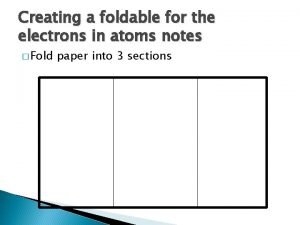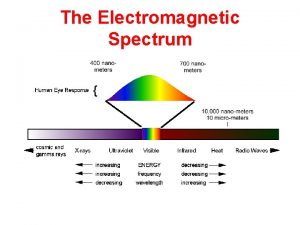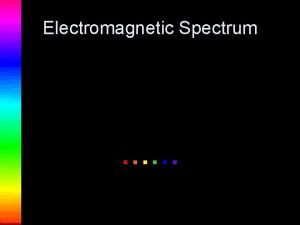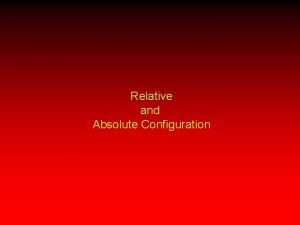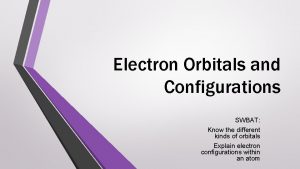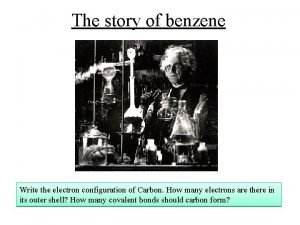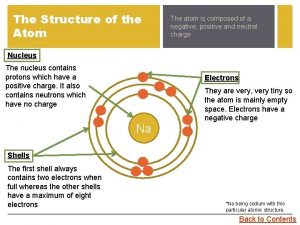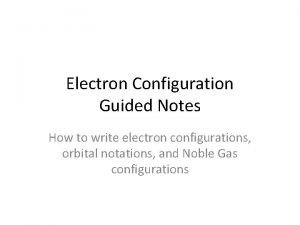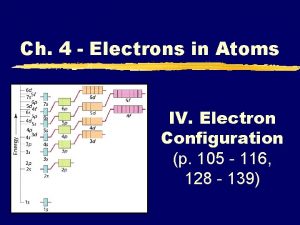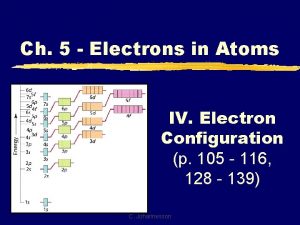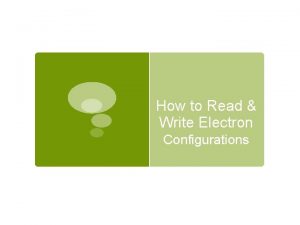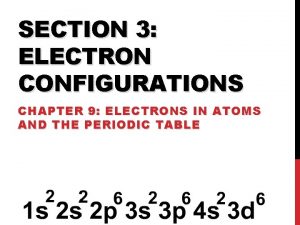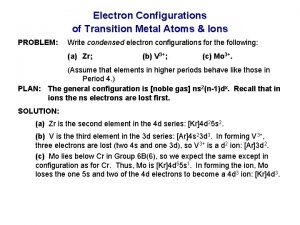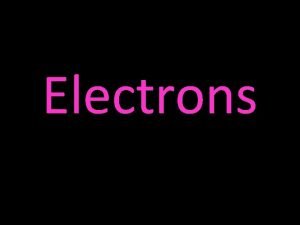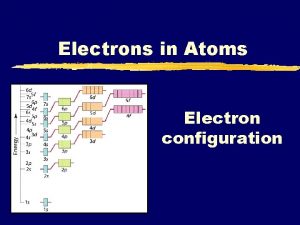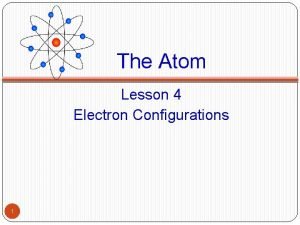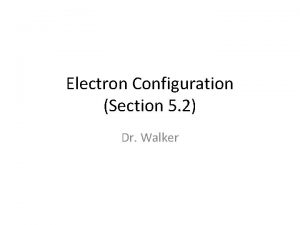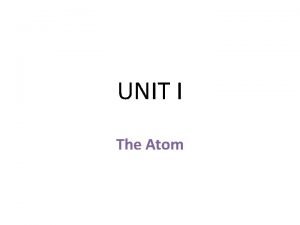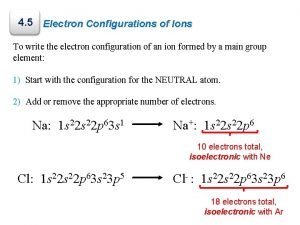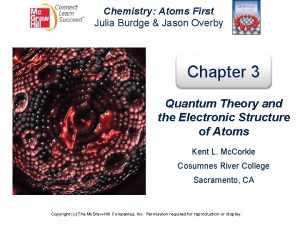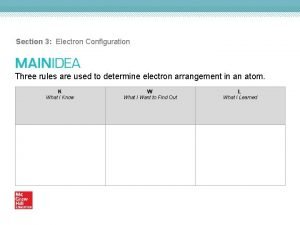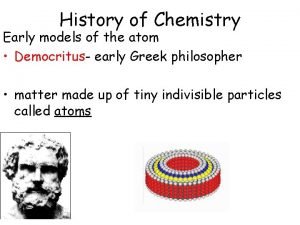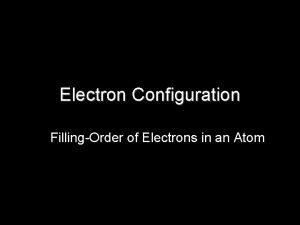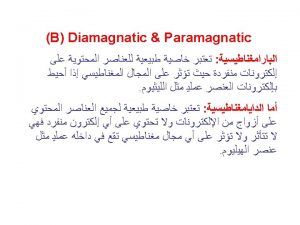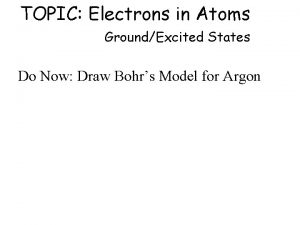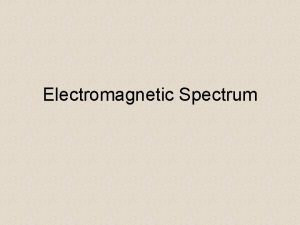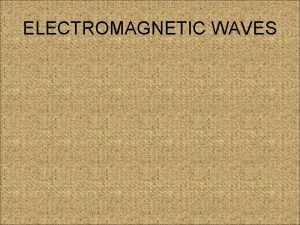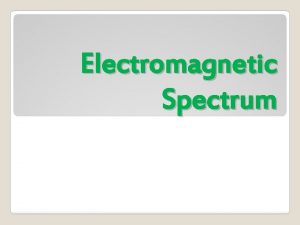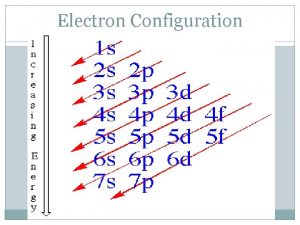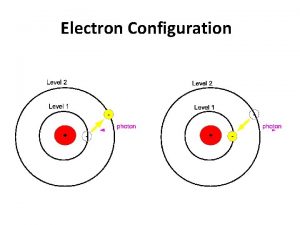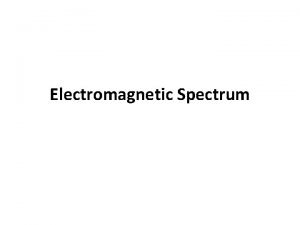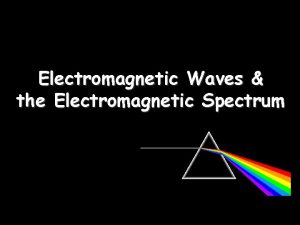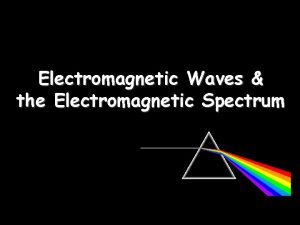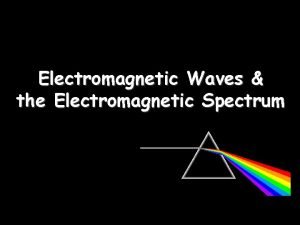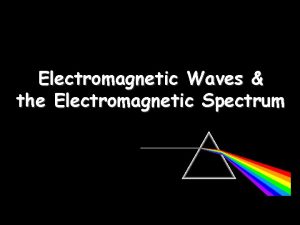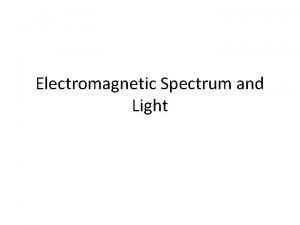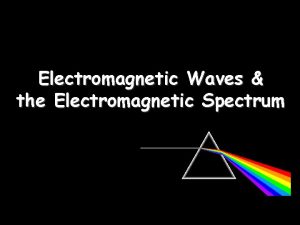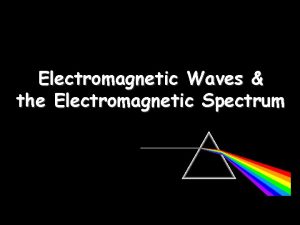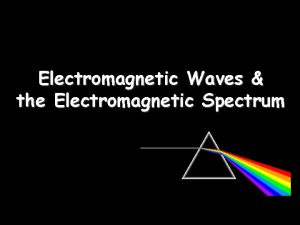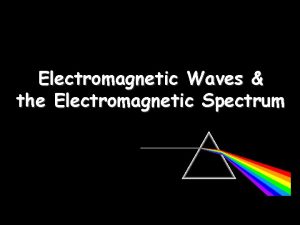Electron Configuration The Electromagnetic Spectrum Know what is


































































- Slides: 66

Electron Configuration


The Electromagnetic Spectrum Know what is in the red boxes High frequency lower frequency Short wavelength longer wavelength High energy lower energy


Jumping Electrons • normally electrons exist in the ground state, meaning they are as close to the nucleus as possible • when an electron is excited by adding energy to an atom, the electron will absorb energy and "jump" to a higher energy level – heating a chemical with a Bunsen burner is enough energy to do this

• Emission line spectrum – energy is applied to a specific element • this “excites” the element • visible light, infrared, and UV can be emitted when electrons fall back down to the ground state • unique for every element and are used to identify atoms (much like fingerprints are used to identify people) http: //www. y outube. com/ watch? v=QI 50 GBUJ 48 s

More on emission line spectrum Give off energy when falls back down to ground energy level

this is a repetitive slide- just couldn’t bear to delete it 1. an electron in the atom gains (absorbs) energy from heating 2. electron jumps up an energy level. 3. electron is now unstable (unwelcome) in this level and is “kicked out” 4. when the electron loses the energy and come back to the original level, light is emitted



Scandium 3 -D video (2: 31) 3 -D Graphic Examples of Atomic Orbitals

Quantum Numbers (however, actual numbers are often not used) • each electron in an atom is described by four different quantum numbers – think of the 4 quantum numbers as the address of an electron… country > state > city > street • electrons fill low energy orbitals before they fill higher energy ones

• Principle quantum number (n) Quick intro, more later. – describes the SIZE of the orbital or ENERGY LEVEL (shell) of the atom. • Angular quantum number (l) – a SUB-LEVEL (shell) that describes the type or SHAPE of the orbital • Magnetic quantum number (m) – the NUMBER of orbitals – describes an orbital's ORIENTATION in space • Spin quantum number (s) – describes the SPIN or direction (clockwise or counterclockwise) in which an electron spins

Principle Quantum # (n) LEVEL/SIZE Angular Quantum # (l) ORBITAL SHAPE or SUBLEVEL Magnetic Quantum # (m) AXIS/ ORIENTATION or ORBITALS 1 s 1 2 s p 1 3 1 orbital 4 total orbitals 2 e- 8 e- 3 s p 1 4 d s p d 5 1 3 5 3 9 total orbitals 16 total orbitals Spin Quantum # (s) DIRECTION OF ELECTRON SPIN 18 e- 32 e- f 7

4 f 14 (7) 4 d 10 (5) 4 p 6 (3) 4 s 2 (1) 32 = level and sub-level = max. # of electrons = number of orbitals 3 d 10 (5) 3 p 6 (3) 3 s 2 (1) 18 2 p 6 (3) 2 s 2 (1) 8 1 s 2 (1) 2

Principle Quantum Number (n) or Energy Level • values 1 -7 used to specify the level the electron is in • describes how far away from the nucleus the electron level is – the lower the number, the closer the level is to the atom's nucleus and less energy • maximum # of electrons that can fit in an energy level is given by formula 2 n 2 (n = energy level)



Angular Quantum Number (l) or SUB-LEVELS • determines the shape of the sub-level • number of sub-levels equal the level number – ex. the second level has two sub-levels, the third has three and so on… • they are numbered but are also given letters referring to the sub-level type – l=0 refers to the s sub-level – l=1 refers to the p sub-level just know this – l=2 refers to the d sub-level – l=3 refers to the f sub-level



Magnetic quantum number (m) or ORBITALS • Electron Orbitals You. Tube 1: 37 • the third of a set of quantum numbers • tells us how many sub-levels there are of a particular type and their orientation in space of a particular sub-level • only two electrons can fit in an orbital • = electron

S sub-level has only 1 orbital only holds two electrons

P sub-level has 3 orbitals holds up to six electrons


D sub-level has 5 orbitals holds up to 10 electrons


F sub-level has 7 orbitals holds up to 14 electrons



Spin quantum number (s) • the fourth of a set of quantum numbers • number specifying the direction of the spin of an electron around its own axis. – only two electrons of opposite spin may occupy an orbit – the only possible values of a spin quantum number are +1/2 or -1/2.


Principle Quantum # (n) LEVEL/SIZE Angular Quantum # (l) ORBITAL SHAPE or SUBLEVEL Magnetic Quantum # (m) AXIS/ ORIENTATION or ORBITALS 1 s 1 2 s p 1 3 1 orbital 4 total orbitals 2 e- 8 e- 3 s p 1 4 d s p d 5 1 3 5 3 9 total orbitals 16 total orbitals Spin Quantum # (s) DIRECTION OF ELECTRON SPIN 18 e- 32 e- f 7

Table 3 -6 b Orbitals and Electron Capacity of the First Four Principle Energy Levels Principle energy level (n) 1 2 3 4 Number of orbitals per type Number of orbitals per level(n 2) s 1 1 2 s 1 p 3 4 8 s 1 p 3 9 18 d 5 s 1 p 3 d 5 16 32 f 7 Type of sublevel Maximum number of electrons (2 n 2)


“Rules” for Writing Electron Configurations • a method of writing where electrons are found in various orbitals around the nuclei of atoms. – three rules in order to determine this: 1. Aufbau principle 2. Pauli exclusion principle 3. Hund’s rule

Aufbau Principle • electrons occupy the orbitals of the lowest energy first • each written represents an atomic orbital (such as or …. ) • electrons in the same sublevel/shell have equal energy ( same energy as ) • principle energy levels/shells (1, 2, 3, 4. . ) can overlap one another – ex: 4 s orbital has less energy than a 3 d orbital

Pauli Exclusion Principle Hamster video 1: 00 • only two electrons in an orbital – must have opposite spins – represents one electron – represents two electrons in an orbital actually incorrect as well, see next slide

Hund’s Rules • every orbital in a subshell must have one electron before any one orbital has two electrons • all electrons in singly occupied orbitals have the same spin.

Writing Orbital Diagrams

Energy




• Orbitals grouped in s, p, d, and f orbitals (sharp, proximal, diffuse, and fundamental) s orbitals d orbitals p orbitals f orbitals




Boron Atomic # 5 http: //colossus. chem. umass. edu/genchem/whelan/class_ima ges/Orbital_Energies. jpg

Boron ion (3+) Atomic # 5 http: //colossus. chem. umass. edu/genchem/whelan/class_ima ges/Orbital_Energies. jpg

Neon Atomic # 10 http: //colossus. chem. umass. edu/genchem/whelan/class_ima ges/Orbital_Energies. jpg

Bromine Atomic # 35 http: //colossus. chem. umass. edu/genchem/whelan/class_ima ges/Orbital_Energies. jpg

Bromine ion (1 -) Atomic # 35 http: //colossus. chem. umass. edu/genchem/whelan/class_ima ges/Orbital_Energies. jpg



1 s 2 s 2 p 3 s 3 p Na 1 s 2 2 p 6 3 s 1 Mg 1 s 2 2 p 6 3 s 2 Al 1 s 2 2 p 6 3 s 2 3 p 1 Si 1 s 2 2 p 6 3 s 2 3 p 2 P 1 s 2 2 p 6 3 s 2 3 p 3 S 1 s 2 2 p 6 3 s 2 3 p 4 Cl 1 s 2 2 p 6 3 s 2 3 p 5 Ar 1 s 2 2 p 6 3 s 2 3 p 6 Orbital diagrams Electron Configurations

Electron Configurations 4 2 p Number of electrons in the sublevel Energy Level Sublevel 1 s 2 2 p 6 3 s 2 3 p 6 4 s 2 3 d 10 4 p 6 5 s 2 4 d 10 5 p 6 6 s 2 4 f 14… etc.

Writing Electron Configurations • To write out the electron configuration of an atom: – use the principal quantum number/energy level (1, 2, 3, or 4…) – use the letter term for each sub-level (s, p, d, or f); • don’t worry about orientation such as x, y, z axis but you do have to be able to draw these for IB – use a superscript number indicates how many electrons are present in each sub-level • hydrogen =1 s 1. • Lithium =1 s 22 s 1. – don’t write anything for spin






Order of Electrons Sometimes levels are switched in order to keep the level together. I hate when they do that! 4 s requires less energy and I think it should be before 3 d. 1 s 2 2 p 6 3 s 2 3 p 6 3 d 10 4 s 2 4 p 6 4 d 10 4 f 14… electron configuration video (3: 24)

• exceptions (don’t need to know this, just be aware that there are exceptions) • orbitals “like” to be empty, half filled, or full • therefore, an electron leaves the 4 s (leaving it half full) and goes to the 3 d in order to make it full Cr we would predict: 1 s 2 2 p 6 3 s 2 3 p 6 4 s 2 3 d 4 but it is actually: 1 s 2 2 p 6 3 s 2 3 p 6 4 s 13 d 5 Cu we would predict: 1 s 2 2 p 6 3 s 2 3 p 6 4 s 2 3 d 9 but it is actually: 1 s 2 2 p 6 3 s 2 3 p 6 4 s 1 3 d 10

Noble Gas Shortcut same
 Electron configuration vs noble gas configuration
Electron configuration vs noble gas configuration Electromagnetic spectrum
Electromagnetic spectrum Electromagnetic spectrum
Electromagnetic spectrum Mnemonic for electromagnetic spectrum
Mnemonic for electromagnetic spectrum Electromagnetic spectrum
Electromagnetic spectrum James clerk maxwell theory of light
James clerk maxwell theory of light Www.darvill.clara/emag
Www.darvill.clara/emag What waves are produced by stars and galaxies
What waves are produced by stars and galaxies Light has a dual nature
Light has a dual nature Types of radiation in the electromagnetic spectrum
Types of radiation in the electromagnetic spectrum Genchem
Genchem Electromagnetic spectrum micrometers
Electromagnetic spectrum micrometers Em waves chart
Em waves chart Chapter 18 electromagnetic spectrum and light
Chapter 18 electromagnetic spectrum and light Radio waves, microwaves song lyrics
Radio waves, microwaves song lyrics Electromagnetic spectrum
Electromagnetic spectrum Electromagnetic spectrum
Electromagnetic spectrum What is the electromagnetic spectrum
What is the electromagnetic spectrum Electromagnetic spectrum with colors
Electromagnetic spectrum with colors Electromagnetic spectrum mnemonic
Electromagnetic spectrum mnemonic Objectives
Objectives Kesler science
Kesler science How radio waves carry information
How radio waves carry information Electromagnetic spectrum foldable
Electromagnetic spectrum foldable Lesson 1 the electromagnetic spectrum
Lesson 1 the electromagnetic spectrum Electromagnetic spectrum foldable
Electromagnetic spectrum foldable Electromagnetic spectrum foldable
Electromagnetic spectrum foldable Electromagnetic spectrum conclusion
Electromagnetic spectrum conclusion Electromagnetic spectrum longest to shortest wavelength
Electromagnetic spectrum longest to shortest wavelength D orbital shape
D orbital shape Absortpion
Absortpion Electromagnetic waves
Electromagnetic waves Relative and absolute configuration
Relative and absolute configuration Relative configuration
Relative configuration Chiral and achiral molecules examples
Chiral and achiral molecules examples Electron configuration boarding house
Electron configuration boarding house Pd electron configuration
Pd electron configuration Electron configuration of ci 17
Electron configuration of ci 17 Electron configuration guided notes
Electron configuration guided notes Stability and electron configuration ch 4
Stability and electron configuration ch 4 Electron configuration for 5 electrons
Electron configuration for 5 electrons Electron configuration how to read
Electron configuration how to read Electrons in atoms section 3 electron configuration
Electrons in atoms section 3 electron configuration Vbt of cr(nh3)6 3+
Vbt of cr(nh3)6 3+ Chemistry electron configuration
Chemistry electron configuration How many electrons can f orbital hold
How many electrons can f orbital hold Na 1+ electron configuration
Na 1+ electron configuration Abbreviated vs unabbreviated electron configuration
Abbreviated vs unabbreviated electron configuration Oganesson electron configuration
Oganesson electron configuration Electron configuration
Electron configuration Abbreviated electron configuration for potassium
Abbreviated electron configuration for potassium Electron configuration
Electron configuration Electron configuration with ions
Electron configuration with ions Orbital diagram for uranium
Orbital diagram for uranium Ground state electron configuration of arsenic
Ground state electron configuration of arsenic What does electron configuration notation eliminate?
What does electron configuration notation eliminate? Orbital diagram for magnesium
Orbital diagram for magnesium 4p7 electron configuration
4p7 electron configuration Section 3 electron configuration
Section 3 electron configuration Electron confuguration
Electron confuguration Halogens reactivity down the group
Halogens reactivity down the group Sulfur electron configuration
Sulfur electron configuration Electrons
Electrons Electron orbitals diagram
Electron orbitals diagram How to find ms in quantum numbers
How to find ms in quantum numbers Excited state electron configuration
Excited state electron configuration Konfigurasi elektron mg
Konfigurasi elektron mg

